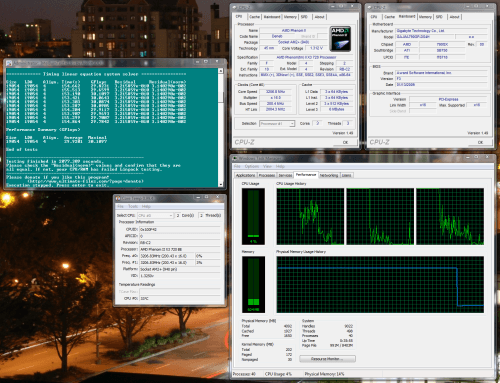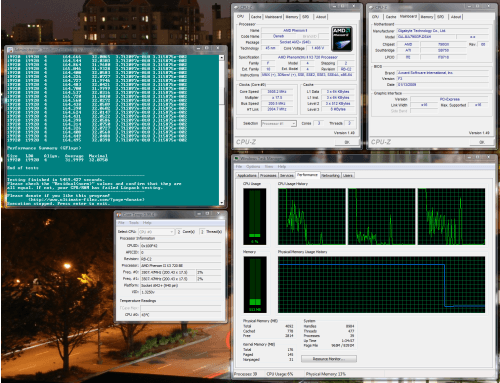- Qualcomm Launches Snapdragon 4 Gen 2 Mobile Platform
- AMD Launches Ryzen PRO 7000 Series Mobile & Desktop Platform
- Intel Launches Sleek Single-Slot Arc Pro A60 Workstation Graphics Card
- NVIDIA Announces Latest Ada Lovelace Additions: GeForce RTX 4060 Ti & RTX 4060
- Maxon Redshift With AMD Radeon GPU Rendering Support Now Available
AMD Phenom II X4 810 & X3 720 Black Edition

Phenom II may have just launched last month, but AMD didn’t want to waste time in following-up with their first AM3-based processors. We’re taking a look at two, including the X4 810 and X3 720 ‘Black Edition’. Both offer great performance at their respective price-points, but the X3 became the more appealing chip, thanks to its overclocking ability.
Page 11 – Overclocking AMD’s X4 810 & X3 720
Before discussing results, let’s take a minute to briefly discuss what I consider to be a worthwhile overclock. As I’ve mentioned in past content, I’m not as interested in finding the highest overclock possible as much as I am interested in finding the highest stable overclock. To me, if an overclock crashes the computer after a few minutes of running a stress-test, it has little value except for competition.
How we declare an overclock stable is simple… we stress it as hard as possible for a certain period of time, both with CPU-related tests and also GPU-related, to conclude on what we’ll be confident is 100% stability throughout all possible computing scenarios.
For the sake of CPU stress-testing, we use IntelBurnTest, for reasons I’ve laid out in a recent forum thread. Compared to other popular CPU stress-testers, IBT’s tests are far more gruelling, and proof of that is seen by the fact that it manages to heat the CPU up to 20°C hotter than competing applications, like SP2004. Also, despite its name, IntelBurnTest is just as effective on AMD processors. Generally, if the CPU survives the first half-hour of this stress, there’s a good chance that it’s mostly stable, but I strive for a 12 hour stress as long as time permits.
If the CPU stress passes without error, then GPU stress-testing begins, in order to assure a system-wide stable overclock. To test for this, 3DMark Vantage’s Extreme test is used, with the increased resolution of 2560×1600, looped nine times. If this passes, some time is dedicated to real-world game testing, to make sure that gaming is just as stable as it would be if the CPU were at stock. If both these CPU and GPU tests pass without issue, we can confidently declare a stable overclock.
Overclocking AMD’s X4 810 & X3 720
Contrary to my heading above, I won’t be talking much about the X4 810, simply because I didn’t spend near as much time overclocking it as I did the X3. Like most AMD Quad-Cores, it just didn’t want to overclock too far, and after finding a stable clock of 2.99GHz, I was unable to push it any further, even with a few hours worth of tweaking. Adding 400MHz to the CPU is nice, but I really don’t think the time invested really makes it worthwhile.
The X3 720 on the other hand is far different. Similar to Dual-Cores, it was a breeze to overclock, and we even managed to push it 400MHz above stock without touching a single piece of voltage, as seen in the image below:

3.20GHz Stable Overclock – 1.325v CPU, Default Secondary Voltages (10 Iteration Test)
That overclock isn’t one to brag about though, because achieving it required next-to-nothing in terms of tweaking. To push the CPU even further though, it became quite a challenge. I’m unsure if temps became an issue at the top-end, or the fact that the CPU just has a hard-limit. Either way, my top stable overclock proved to be 3.50GHz, which required a bump of 0.075v, to settle in at 1.40v:

3.50GHz Stable Overclock – 1.40v CPU, Default Secondary Voltages (25 Iteration Test)
Due to time constraints, I wasn’t able to put these chips through gruelling half-day stress-tests, but with what we’ve accomplished here, I’m rather confident these are indeed stable. IntelBurnTest is such a hardcore CPU tester, that normally any instabilities are found out about in under the first five iterations. If you get past ten, you are likely going to soar through to infinity.
Support our efforts! With ad revenue at an all-time low for written websites, we're relying more than ever on reader support to help us continue putting so much effort into this type of content. You can support us by becoming a Patron, or by using our Amazon shopping affiliate links listed through our articles. Thanks for your support!





